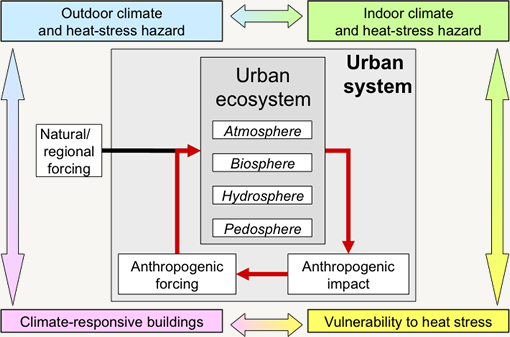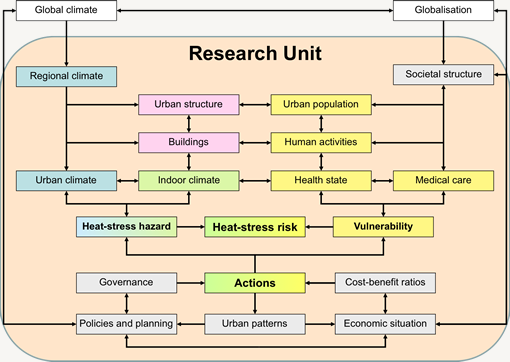Urban-system framework and research topics
The figure below presents the conceptual urban-system framework used in the UCaHS Research Unit. The urban system is conceptualised as being composed of urban ecosystems in which natural processes take place within the different spheres, and the anthroposphere covering all aspects of human activities and decision-making. Humans as organisms are part of the biosphere, thus heat stress is taking place within urban ecosystems. However, the consequences of heat-stress for individuals and the society, and the subsequent actions for reducing both the hazards and the vulnerabilities are part of the anthroposphere. Actions able to effectively reduce heat-stress hazards are addressing buildings as the major constitutive element of urban systems. Both out- and indoor effects of buildings were studied. Reduction of heat-stress hazards requires modifying out- or indoor weather and climates.
Extreme weather as well as climate change is caused by variations or changes in natural or regional forcing driving urban weather and climate. Thus, these controls are regarded being external to the urban system (although the urban system will influence e.g. radiative forcing by its greenhouse gas emissions on longer time scales).

- Conceptual urban-system framework underlying the Research Unit´s structure and work plan. The box colours, also used in other figures, refer to the individual Research Modules.
The individual topics relevant to study heat stress are shown in the next figure. The central topic is given by heat-stress risks stemming from both heat-stress hazards caused by the urban environment and the vulnerability of the elements at risk to these hazards.
Meso- to micro-scale processes in urban ecosystems are causing hazardous atmospheric conditions leading to heat stress, which is part of the anthropogenic impact. Urban ecosystem processes themselves are driven by forcing mechanisms, which are partly external factors (e.g. macro-scale climate conditions) with respect to the urban system, but also result from anthropogenic forcing taking place within the urban system itself. The feedback loop shown in the figure above is closed by urban development linking anthropogenic impact to anthropogenic forcing. Such links are actions for mitigation of or adaptation to anthropogenic impact.
A major concept of the Research Unit was based on a formally strict use of the terms hazard, vulnerability and risk. The same held true for quantification of effectiveness and efficiency of actions for reducing heat-stress risks. The effectiveness of actions was measured either by directly determining the sensitivity of urban-ecosystem processes to changing anthropogenic forcing, or indirectly by relating the change in anthropogenic impact to the corresponding change in anthropogenic forcing. Efficiency of actions was determined by their cost-benefit-ratios, which required defining a common scaling system for quantifying the benefits. Mean annual energy consumption of buildings was regarded to form a suitable common scaling system, but other systems (e.g. fatalities or money) were also applied wherever applicable.

- Research topics. The box colours refer to the individual Research Modules or the Conceptual urban-system framework as shown in the other figure above